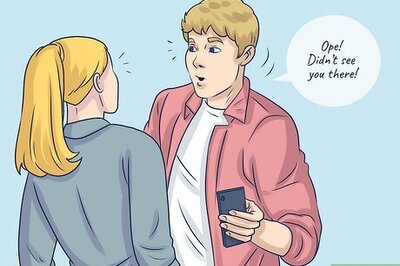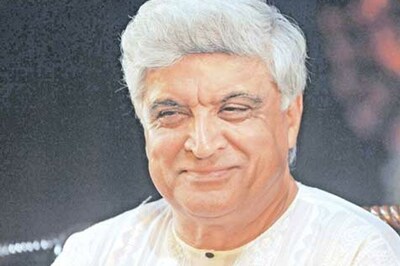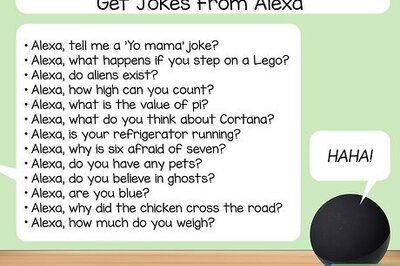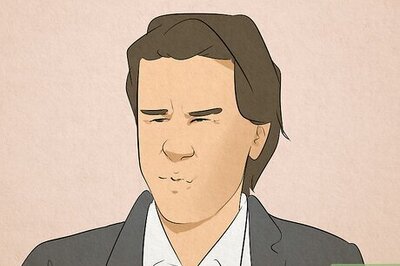
views
Eye Signals and What They Mean
Darting eyes This cartoonish expression can be viewed as a sign of nervousness or insecurity. However, the direction that the eye is darting to could give something more specific away. Looking up tends to be correlated with memory and imagination, with the person trying to conjure up a relevant image. Looking frantically from side to side implies the processing of words and emotions. Looking down is essentially synonymous with looking inward and can be used as a respite from the conversation in order to arrive at an appropriate response. Darting eyes can hint at other negative emotions like suspicion, intent to deceive, and contempt. Darting eyes are not the only clues to help you spot a liar, as lying is thought to involve several different notable changes in body language.
Looking someone up and down This indicates one of three things: that you’re attracted to the person you’re looking at, or that you’re using this sweeping gaze as an intimidation tactic, or as a response to one. When paired with dilated pupils and flared nostrils, often used to take in pheromones, looking at another person up and down is a clear sign that you’re interested in them and like what you see. When this visual sweep is met with crossed arms or otherwise closed body language, it could be a sign of trouble between the two parties. The “triangular” gaze, or looking back and forth between someone’s eyes and mouth, further suggests romantic attraction. Looking away and then back again is yet another clue that the person is interested in being friends… plus perhaps a bit more.
Holding a gaze Maintaining eye contact is a tried-and-true method of building rapport and a very important aspect of non-verbal communication. People are more likely to think you like them, respect them, and/or value them if you can hold their gaze for at least 60% of your interaction. Eye contact is also a good way of indicating interest, affection, and attraction. Similarly, it points to certain power dynamics, with employees feeling favored by their bosses after exchanging extended eye contact. Studies have shown that maintaining a gaze with an audience during a meeting or presentation is more likely to help them register and remember what you said. Short flashes of eye contact indicate shyness or discomfort, whereas longer durations hint at more confidence and assertiveness.
Wide eyes A 2017 study determined that the openness of the eye was one of the main indicators of emotion when reading facial cues. A widened eye, in which the whites of the eyes are clearly visible, may reflect feelings of awe, fear, or surprise. Widened eyes lead to better peripheral vision, so it could also be something left over from our hunter-gatherer ancestors, used to suss out our surroundings for signs of danger. Scientists and body language experts associate wide eyes with positive or neutral emotions, while narrowed eyes can hint at suspicion, contempt, and even disgust.
Dilated pupils If you’re speaking to someone and their pupils are dilated, that likely means they’re attracted to you! At the very least, there’s something about you they like or find stimulating. As it turns out, pupils dilate when presented with pleasant, attractive, or arousing information, whether that be in the form of a celebrity photo, a cheesy pizza, or a difficult puzzle. Conversely, pupils have been known to dilate due to a range of other overwhelming emotions, including anger. A 2019 study showed 2 images of the same person to participants: one image with dilated pupils and one with constricted pupils. Then, they asked participants which version looked more pleasant– the ones with dilated pupils won by a landslide. Constricted pupils, like narrowed eyes, can be used to “zoom in” on a situation, assessing whether it’s safe or not.
Eyebrow raise An eyebrow raise, or flash, occurs when someone briefly lifts their eyebrows, often in passing as a greeting. Research has discovered that this expression is universal, used in virtually all cultures and parts of the world. Surprise is another reason behind raised eyebrows, such as when receiving good news. The difference between a pleasant greeting and a look of surprise is the length of the eyebrows raise, with surprise reactions lasting longer. Additionally, raising one’s eyebrows can also be used to underscore a specific statement or emotion, as well as letting someone know you’re listening and engaged during conversation. A singular raised eyebrow can be considered a sign of surprise, delight, or suspicion, depending on the body language its coupled with. A single raised brow met with open body language and smiling is a good indicator of a positive interaction, while a raised brow with crossed arms points to potential conflict.
Winking This popular expression is mainly used to flirt, conveying feelings of attraction, interest, and cheekiness. Moreover, winking can also be used as means to take a break from intense eye contact with someone you find enticing, offering a moment of relief. Almost always guaranteed to elicit a smile, winking can serve as a playful reminder of an inside joke, too, or as a sassy way to suggest keeping a secret among friends. A 2009 college campus study showed that winking was associated with flirtation, gratitude, and general friendliness.
Extended blinking Fast, extended eye blinking tends to take place between two people who are romantically linked, or want to be. Synonymous with “batting the eyelashes,” extended blinking might be accompanied by a lowered head tilt and a seductive smile. On the other hand, this kind of blinking might simply be buying a person time when they don’t know what to say or are under pressure, like at a business meeting or school presentation. For women, eye-batting may be used as a flirtation tactic used to make their faces more feminine, angelic, and baby-like.
Additional Tips for More Accurate Eye Interpretation
Learn other people’s baseline eye movements. The key to deciphering other peoples’ eye movements is to be able to identify that they’re different from what they normally do. Establishing a baseline for how often they look around and blink, as well as the length of their stare is instrumental in really figuring out what they have to say without them actually saying it. Here are some tips on how to do it: Notice their eyebrows– are they typically animated and expressive or generally sitting neutrally on the face? Do they appear to have a preference in sides when looking around? If so, a change in this could indicate stress.
Note that eye contact practices vary across cultures. When attempting to analyze the behavioral cues of others, it’s important to understand that eye signals carry different meanings across cultures. For example, maintaining eye contact is considered a sign of confidence and decisiveness in America. The same is not true in some Asian cultures, as they consider eye contact to be disrespectful, especially if the person being stared at is an elder or an authority figure. In the Middle East, eye contact between two people of the same gender is held longer and considered more appropriate than prolonged eye contact between opposite genders. In a Western context, lowered eyebrows may be perceived as dominant. In countries like Thailand, raised eyebrows are considered a dominant expression. Understanding the cultural significance of a certain facial expression or movement is critical in deciphering its meaning.
Don't pass judgement on eye signals alone. Eye signals are best read and understood when coupled with other physical cues. Body language analysis isn’t an exact science and identifying someone’s state of mind based off eye signals alone is typically not enough to paint a full picture. Instead, try to decode other behavioral cues coupled with their eye movements for a more accurate and comprehensive character study. For example, when trying to figure out if someone is lying, you should take into account the following factors: facial expressions, shifts in bodily movements, tone of voice, and the content of what they’re saying. Liars tend to use their hands after they’re done speaking, as the brain is too busy fabricating a story to do both at the same time. A high pitched voice is often a result of nerves, and therefore, hints that someone is lying. Darting eyes or looking to one side can further support this theory, as it can mean they’re trying to think of what to say next. Experts have not agreed upon a universal method of identifying a liar and this prospect has caused some conflict in the community as some people believe that the bodily cues we see are still filtered via our own subjective and unique lens of perception. It’s also important to note that body language can fulfill several different roles, like repetition to reinforce your message and complimenting, which adds visual cues to your verbal communication.




















Comments
0 comment